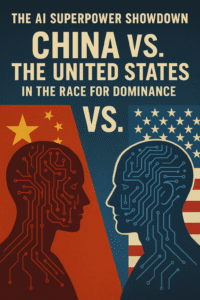The AI Supremacy Showdown: China vs. the United States in the Race for Dominance
 The landscape of global power is undergoing a seismic shift, driven by the relentless advancement of Artificial Intelligence (AI). In this high-stakes race for technological / AI supremacy, two undisputed superpowers have emerged as fierce competitors: China and the United States. Both nations recognize AI’s transformative potential to reshape economies, militaries, and geopolitical influence, pouring billions into research, development, and deployment. This contest transcends mere technological bragging rights; it’s increasingly viewed as pivotal in determining the economic, political, and military hierarchy of the coming decades. So, where does this intense rivalry stand?
The landscape of global power is undergoing a seismic shift, driven by the relentless advancement of Artificial Intelligence (AI). In this high-stakes race for technological / AI supremacy, two undisputed superpowers have emerged as fierce competitors: China and the United States. Both nations recognize AI’s transformative potential to reshape economies, militaries, and geopolitical influence, pouring billions into research, development, and deployment. This contest transcends mere technological bragging rights; it’s increasingly viewed as pivotal in determining the economic, political, and military hierarchy of the coming decades. So, where does this intense rivalry stand?
China’s Strategy: Centralized Power and Data-Driven Scale
China’s approach to AI stands in stark contrast to the US model. Its most defining characteristic is centralized state control. AI is a cornerstone of China’s national strategy, explicitly aiming for global leadership by 2030. The 2017 “Next Generation Artificial Intelligence Development Plan” laid out a comprehensive roadmap, backed by substantial state funding and directed investment through state-linked private giants.
China possesses a formidable advantage: unparalleled data access. Its population of over 1.4 billion provides a massive dataset for training AI models, a scale difficult to replicate elsewhere due to privacy constraints. This fuels technologies like facial recognition, ubiquitous in Chinese cities, generating vast behavioral data troves.
Rapid deployment is another hallmark. Massive investments in technological infrastructure and rapid industrialization create fertile ground. Cities like Shenzhen buzz with AI startups, fuelled by heavy R&D spending from Baidu, Alibaba, and Tencent (BAT). The government actively cultivates talent through specialized institutes and funding initiatives.
This strategy yields impressive results, particularly in facial recognition, robotics, and autonomous vehicles, where China is often seen as pulling ahead. However, significant challenges persist:
Ethical Concerns: Extensive AI surveillance (e.g., the Social Credit System) raises major alarms about civil liberties and authoritarian control.
Intellectual Property: Accusations of IP theft undermine trust and invite international pushback.
Legal Framework: A less robust legal system complicates ethical governance and international collaboration.
Secrecy: Lack of transparency fuels global apprehension.
Despite these hurdles, China’s top-down, state-driven model enables swift, decisive action in the AI arena.
The United States’ Edge: Innovation, Academia, and Soft Power
The US approach leans heavily on a decentralized, market-driven ecosystem. Tech titans like Google, Amazon, Microsoft, and Meta (formerly Facebook) are powerhouses of AI research and application, leveraging immense capital, talent, and a culture of innovation. While potentially slower than China’s coordinated efforts, this model fosters groundbreaking advancements.
A core US strength lies in its world-leading academic and research institutions. Universities like Stanford, MIT, Carnegie Mellon, and Harvard are global hubs for cutting-edge AI research. This is coupled with a vibrant culture of entrepreneurship and risk-taking, spawning numerous successful AI startups.
This potent mix of academia and industry maintains the US lead in critical domains like Natural Language Processing (NLP), machine learning algorithms, and advanced robotics. The US is home to some of the most powerful AI systems globally:
OpenAI’s GPT models (like ChatGPT)
Google DeepMind’s AlphaFold and AlphaGo
Tesla‘s Autopilot/Full Self-Driving systems
Furthermore, a strong open-source culture facilitates widespread collaboration and rapid progress. The US also wields immense soft power and global influence. Services like Google Search, Amazon Web Services (AWS), and Microsoft Azure underpin much of the global digital economy, creating a self-reinforcing cycle of growth and innovation that keeps the US at the technological forefront.
The Military Arena: AI as a Strategic Imperative
AI’s significance extends far beyond commerce; it’s rapidly becoming a cornerstone of military power. Both superpowers are heavily investing in AI-driven defense applications.
China: Openly prioritizes military AI, focusing on advanced autonomous weapon systems (drones, ground vehicles) and pervasive surveillance technology. The goal is a highly efficient, autonomous fighting force. However, its secrecy and lack of independent oversight fuel significant ethical concerns regarding autonomous warfare.
United States: Has a long history of integrating AI into defense (e.g., Project Maven for drone surveillance, DARPA programs). The US military actively explores AI-powered weapon systems. While also facing ethical questions, the US generally operates with greater transparency and established (though debated) accountability frameworks compared to China.
Both nations see AI as critical for future combat dominance, making this a vital and sensitive front in their competition.
Ethical Crossroads: The Shadow Over Progress
As the race for AI Supremacy intensifies, the ethical implications of AI development loom large. Both countries face intense scrutiny:
China: Faces widespread condemnation over its use of AI for mass surveillance, social control (Social Credit System), and suppression of dissent, raising fundamental human rights concerns.
United States: Grapples with the lack of comprehensive federal privacy legislation. Exploitative data practices by major tech companies highlight the tension between innovation and consumer rights/privacy, especially compared to frameworks like the EU’s GDPR.
Addressing these ethical challenges is not just a moral imperative but crucial for maintaining global legitimacy and trust. How each nation navigates the intersection of AI, ethics, and human rights is being closely watched worldwide.
AI Supremacy: Who’s Leading the Race?
Declaring a clear victor in the AI Supremacy race is premature. The strengths are complementary yet distinct:
China: Holds a significant edge in rapid deployment, scaling infrastructure, and leveraging massive datasets, particularly evident in surveillance, facial recognition, and certain robotics applications. Its centralized model enables swift, large-scale execution.
United States: Maintains a strong lead in fundamental research, breakthrough innovation, academic excellence, and the development of powerful commercial AI systems (NLP, complex algorithms). Its decentralized ecosystem fosters creativity and houses dominant global tech platforms.
The Verdict: Beyond a Simple Winner
The ultimate outcome won’t be decided solely by technological milestones. It hinges on how each nation:
Navigates the ethical minefield: Can they develop and deploy AI responsibly?
Manages geopolitical tensions: Will competition foster dangerous conflict or allow for necessary cooperation on global challenges?
Adapts their models: Can the US accelerate deployment without sacrificing its innovative edge? Can China foster genuine innovation and address ethical concerns within its controlled system?
The AI Supremacy race is far from over. The future will likely involve a complex mix of intense competition, cautious cooperation on shared risks (like AI safety), and unavoidable friction. The critical question is evolving: It’s no longer just “Who’s winning?” but rather “How will the world navigate the profound economic, societal, and ethical consequences unleashed by the AI age?” The strategies and choices of China and the US will profoundly shape the answer for decades to come.
If you enjoyed this article, you can explore more on similar topics here: Science & Tech Articles

I got this site from my friend who told me on the topic of this web site and at the
moment this time I am browsing this web page and reading very informative articles
or reviews here.
I like what you guys tend to be up too. This type of clever
work and coverage! Keep up the terrific works guys I’ve included you guys to
my own blogroll.
Admiring the dedication you put into your blog and in depth
information you present. It’s great to come across a blog every
once in a while that isn’t the same outdated rehashed information. Wonderful
read! I’ve bookmarked your site and I’m including your RSS feeds to
my Google account.
Why people still make use of to read news papers when in this technological globe the whole thing is existing on net?
It’s very trouble-free to find out any matter
on web as compared to books, as I found this paragraph at this website.
Quality articles is the crucial to invite the users to go to
see the web page, that’s what this site is providing.
I am curious to find out what blog system you are utilizing?
I’m experiencing some minor security problems with my latest blog and
I would like to find something more risk-free. Do you have
any recommendations?
Pingback: SpaceX and the Human Dream of Space Travel
I love reading through a post that will make men and
women think. Also, thanks for allowing me to comment! https://tichmarifa.blogspot.com/2025/08/blog-post.html
always i used to read smaller articles which also clear their
motive, and that is also happening with this piece of writing which I am reading here. https://tichmarifa.blogspot.com/2025/08/blog-post.html
Hi there! This is my first comment here so
I just wanted to give a quick shout out and say I truly enjoy reading through your articles.
Can you recommend any other blogs/websites/forums that
cover the same topics? Appreciate it! https://tichmarifa.blogspot.com/2025/08/blog-post.html